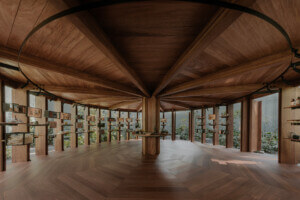On August 3, 2022, the world lost fashion designer Issey Miyake. Known for his unique, formless clothing designs and use of non-traditional materials, Miyake quickly became a household name in the fashion world and an inspiration to other designers in fashion and further afield.
Born in Hiroshima, Japan, on April 22, 1938, Miyake’s life was shaped by the 1945 bombing of the city. Although he rarely spoke about this destruction as to avoid being labeled as the “designer that survived the atomic bomb,” he was shaped by this tragedy. He is quoted saying that he would rather “think of things that can be created, not destroyed, and that bring beauty and joy.” Miyake was part of a unique class of designers and creatives that used the tragedy of war to help shape a postwar Japan. He is often mentioned as part of Japan’s “Big Three” fashion designers with Rei Kawakubo of Comme des Garçons and Yohji Yamamoto. “I gravitated towards the field of clothing design, partly because it is a creative format that is modern and optimistic,” he said in a 2009 op-ed for The New York Times.
Miyake’s choice to enter fashion came from a desire to make a better future. Miyake’s work was also influential for architects. It can be seen in the explorations of pleating and folding, the design of his stores by well-known architects, and in how generations of stylish creatives and architects dressed themselves.
Design through materials
Placing focus on material and form, Miyake’s idea of “peeling away at the limit” steered away from traditional ideas for fashion and instead returned to more elemental moves. His work wasn’t a cold minimalism but instead embodied an ethos of “Less, but better.” His clothing focused mainly on form, or a form which results from a lack of other shapes. Inspired by past fashion designers like Madeleine Vionnet and her technique of not cutting fabrics, his garments draped to the human body, but had a flair of movement, partly inspired by his love for dance. Miyake also incorporated nontraditional materials into his fashion designs, at times using pineapple fibers, bamboo, wood pulp, jute, mosquito nets, and mud-dyed cotton into his clothing in order to realize more natural and organic designs.
Design through form
Miyake’s most popular design came from a very architectural concept. In the 1980s, Miyake developed a patented method of pleating fabric using heat, resulting in his 1993 line Pleats Please. The process entails “construction garments at two or three times their intended size, then precisely folding, ironing and lacing the sewn ensembles, sandwiched between paper, into a heat press,” according to The Met. “The finished garments are permanently pleated and can be washed and air dried without losing shape.”
It’s a notable cultural synergy that ideas of pleating and folding single surfaces was popular in architecture in the ‘90s, inspired in part by Gilles Deleuze’s 1988 book The Fold: Leibniz and the Baroque. The Baroque style used contrast, movement, exuberant detail, deep color, grandeur, and surprise to achieve a sense of awe. In architecture, the fold was seen as a detail that participates in the creation of a larger singular entity, a linkage that’s still relevant under discussions of “part-to-whole” relationships. This articulation is exactly what elevated Miyake’s pleated inventions.
The linkage was acknowledged previously: Giuliana Bruno, Emmet Blakeney Gleason Professor of Visual and Environmental Studies in the Department of Art, Film, and Visual Studies at Harvard University, addressed this overlap in her article “Pleats of Matter, Folds of the Soul” in the first issue of Log, published in 2003. “The fold, often misunderstood in architectural discourse as a mere formal device, is actually an elaborate mutual figuration of mind and matter,” she wrote. Bruno further explored the fold and Miyake’s influence in her 2014 book Surface: Matters of Aesthetics, Materiality, and Media, published by the University of Chicago Press.
Design through space
Miyake used his showrooms to further present his design thinking to the world. He worked with young architects, and their showrooms became a textbook example of retail design becoming an extension of a fashion brand’s vision and identity. Included below are some noteworthy showrooms designed for Issey Miyake.
Issey Miyake/From First (Aoyama, Japan, 1976)
Miyake brand’s first standalone showroom was in the historic From First Building and contributed to a special breakthrough in Japanese retail design. A young Shiro Kuramata designed the space; Miyake commissioned him after seeing his design work for the Milk and Milk Boy showroom two years earlier. The desire was for the shop to feel warm, so Kuramata used a combination of wood and brushed aluminum throughout the space to accomplish this mood. He also covered the entire floor with a jute mat. In a now-classic move of Kuramata magic, the center point of the shop was a 7-foot–10-inch–long cantilevered display table that seemed to float in the space.
Kuramata would go on to design other showrooms and products for Miyake.
View this post on Instagram
Issey Miyake (London, 1985)
Designed by architect David Chipperfield and Kenneth Armstrong, this showroom replaced a previous Miyake showroom. The goal for this space was to design an interior that did not visually represent a “Japanese fashion brand’s shop” but instead to evoke the spirit of Japanese architecture. To accomplish this, Chipperfield and Armstrong focused on the use of natural materials and created a warm, welcoming space using sycamore and limestone.
View this post on Instagram
Issey Miyake Men (New York, 1989)
Located at 77th Street and Madison Avenue in New York, Miyake’s first freestanding showroom in the U.S. was designed by Toshiko Mori and Shiro Kuramata. The interior feels like being inside an ocean liner at sea. The walls were lined in corrugated aluminum panels and thin steel tubes spanned the length of the space to be used as clothing hangers. A V-shaped protrusion was included in the center of the space; its glass panels reflected blue light that emanated from the shop’s lower level.
In a statement shared with AN, Toshiko Mori remembered Miyake:
I thought Issey will live forever. Issey is immortal, I thought. Not only was he a revolutionary fashion designer, he was a center of contemporary design culture and promoted design debates, including most recently on his 21_21 DESIGN SIGHT. He influenced contemporary design at large through his vision, aesthetics, and incorporation of technology and ecology early in his career. He connected material resources to making and fabrication processes. He was also an advocate for peace and was an anti-nuclear activist. I was lucky enough to work with him and visit him in his studio. I will always remember his smile and well-disciplined, gentle personality.
Mori also designed a New York location for Pleats Please, completed in 1998, and another New York showroom for Miyake on 79th Street, finished in 2005.
View this post on Instagram
A-POC/Issey Miyake (Paris, 2000)
Designed by design duo (and brothers) Ronan and Erwan Bouroullec for the A-POC brand, this new brand supported Miyake’s concept of creating clothing outside of the confines of traditional fashion. The Bouroullecs designed the space so it could be changed along with the clothing designs which evolved every six months. The space was framed by a Corian-clad device that ran along the walls, windows, and ceiling. This allowed for the clothing to be folded, hung, and draped in a unique way throughout the space as the new collections arrived.
Issey Miyake Men (Sendai, Japan, 2000)
Designed by Ito Masaru Design Project, this space displayed wares through a skeletal structure of stainless steel tubes faced with acrylic. Rows of linear, industrial-feeling fixtures illuminated the clothing. This allowed the pieces to “float” within the space. Ito Masaru Design Project said that the theme of the shop design was “consciousness within the unconscious.” The design focused on the products, showcasing them in a manner that was slick and cold, while remaining deeply stylish.
Issey Miyake (New York, 2001)
Frank Gehry, Miyake’s longtime friend, and Gordon Kipping designed this space, which evokes Gehry’s Bilbao-era style of deconstructivism. (Perhaps Gehry’s draped, surficial productions were inspired by Miyake’s work.) The main feature of the interior is a 25-foot-long titanium sculpture named The Tornado. The sculpture’s concept came from a conversation between Miyake and Gehry in which they imagined a tornado tearing through the space, transforming everything in its path. The dented, drooping metal sheets brilliantly communicated this feeling in the space.
Kipping also designed a location for Miyake on Madison Avenue.
View this post on Instagram
The significance of architecture and fashion projects for both the architects and fashion brands cannot be understated. These early commissions provide an opportunity for architects to showcase their skills and abilities in a public setting. Additionally, architects who design furniture may incorporate their pieces into these spaces as a way to further demonstrate their expertise. Similarly, fashion brands can use these spaces to build an extension of their brand that can be experienced through exploration and revisitation. The convergence of architecture and fashion is evident in these spaces’ shared focus on aesthetics, innovative materials, and manufacturing techniques. These often-ephemeral spaces make an impact both for the related industries of architecture and fashion, as well as on the public at large.
Josh Itiola is a designer and writer based in New York City.











